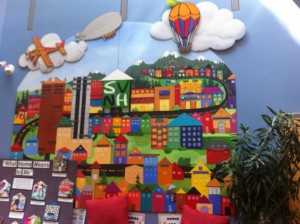Recently, myself and the two other students placed at South Vancouver Neighbourhood House had planned on facilitating a discussion to gain input for our final project. Although this didn’t go as planned, we discovered vital information that has helped narrow the focus for our group project. One question that I was interested in answering was what the participants hoped to gain from their time there. One member explained that she had joined not to achieve a specific end result, but instead to engage in the process of being part of the group; it was the journey, not the destination. She also mentioned that she wanted to connect to and communicate with other women in the community. I would like to find out if this is a common view. Since the women’s group is not a registered program, most participants don’t attend regularly, so embarking on a specific project together would be difficult. From this, we began to think about a final project to promote the women’s group, in order to encourage more immigrant women in the community to come together.
We would our final project to be something that can be left with the women in the group and will benefit them, which has led us to the idea of designing a brochure to attract new members. The brochure would list basic information, but would also explore the group’s role in building community, from the perspectives of the members and the group leader. In this way, we would be able to incorporate into the final project the valuable information found in our interviews. I would also complete an individual paper as part of my project, and as part of this I will be able to reflect on the tensions in the different ways that this group is imagined and defined.
Bonnie Stone Sunstein & Elizabeth Chiseri-Strater point to the identification of unity and tension within sources of data collected during fieldwork as important to the research process. Through my research process, I hope to uncover this unity and tension within the women’s group and within the SVNH. One example of unity is evident in how the words of the above mentioned group member parallel the themes in a particular piece of artwork located in the lobby of the SVNH (see below). In this piece, the road seems to be a metaphor for the emphasis on the journey rather than the destination. In fact, the end of the road does not lead to a specific destination. This echoes how the group member talked about her purpose for being there. Also, in this piece of art, the SVNH appears as the focal point of the neighbourhood, which gives the context of how SVNH positions itself/sees its role within the community. I would like to explore whether there are tensions between how SVNH envisions itself and how the community sees it. I hope that the exploration of the tensions and unity will ultimately result in a more comprehensive project, with attention paid to the details that, while vital to group functioning, are often hidden from the view of outsiders.
Works Cited
Chiseri-Strater, Elizabeth & Sunstein, Bonnie Stone. 2007. FieldWorking: Reading
and Writing Research. Upper Saddle River, NJ: Prentice Hall.

